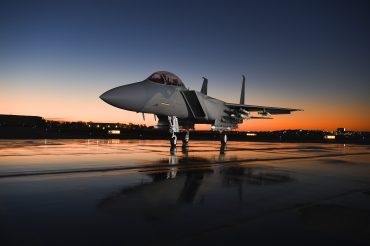
- Aerospace Defense
- Space Tech
Morgan Stanley Lifts Boeing, Sees Aerospace Outperformance
5 minute read

Aerospace industry’s resilient supply chains and defense contracts shield manufacturers from global economic headwinds and trade disputes
Key Takeaways
- Morgan Stanley calls aerospace and defense a “triple threat” that’s “China, tariff, and recession proof,” raising price targets across coverage including Boeing to $235 and TransDigm to $1,750.
- Trump’s expanded tariffs create 18-23% effective rates on imports, the highest since the early 1900s, with Morgan Stanley warning of third-quarter profit impacts on smaller corporations.
- Aerospace stocks trade at 39% premium to S&P 500 on forward EV/EBITDA basis, with supply chain improvements and strong air traffic demand driving sector outperformance.
Introduction
Morgan Stanley positions aerospace and defense as the ultimate defensive play amid escalating global trade tensions and economic uncertainty. The investment bank reaffirms its bullish stance on the sector, describing it as a “triple threat” that remains insulated from China-related disruptions, tariff impacts, and potential recession pressures.
The firm raises price targets across its coverage ahead of second-quarter results, citing improved supply chain dynamics and sector resilience. This positioning comes as aerospace stocks continue trading at significant premiums to broader market valuations, reflecting investor confidence in the sector’s defensive characteristics.
Key Developments
Morgan Stanley’s recent analysis highlights favorable supply and demand dynamics driving sector performance. Aerospace stocks currently trade at a 39% premium to the S&P 500 on a forward EV/EBITDA basis, surpassing expectations since recent market liberation.
The bank’s analysts prefer companies with dual exposure to both aftermarket services and original equipment manufacturing. TransDigm, Howmet, RTX, and Loar receive Overweight ratings based on their ability to navigate industry disruptions effectively.
Price target increases reflect strengthening fundamentals across the sector. Notable revisions include TransDigm raised to $1,750, Howmet to $210, RTX to $165, and Boeing to $235, driven by supply chain improvements and robust air traffic demand.
Market Impact
The aerospace sector’s multiple expansion reflects growing investor recognition of its defensive qualities. Morgan Stanley notes that Boeing’s output continues strong momentum, supporting broader sector optimism despite previous operational challenges, according to the company’s Q2 results.
Defense companies face market undervaluation despite positive budget trends and modernization spending. Lockheed Martin and Northrop Grumman receive Overweight ratings, benefiting from missile-related program expansions and defense modernization efforts.
Global tensions provide additional tailwinds for defense contractors, with Morgan Stanley viewing the sector as well-insulated from geopolitical disruptions while maintaining upside potential.
Strategic Insights
The sector’s resilience stems from structural advantages that differentiate it from cyclical industries. Long-term contracts, essential mission-critical services, and limited competition create defensive moats against economic volatility.
Companies with diversified revenue streams between commercial aerospace and defense segments demonstrate superior positioning. This dual exposure provides stability during commercial aviation downturns while capturing defense spending increases.
Supply chain localization trends favor domestic aerospace manufacturers as governments prioritize national security considerations. This shift creates competitive advantages for established players with existing infrastructure and security clearances.
Expert Opinions and Data
Morgan Stanley analysts emphasize the sector’s unique positioning in current market conditions. “In our view, this multiple expansion reflects the triple threat that is Aerospace as an industry,” the firm states in its research note.
The bank’s coverage team sees defensive characteristics extending beyond traditional metrics. “We see these companies well-positioned to react to disruptions in the industry from tariffs or unforeseen events,” according to Investing.com.
Defense sector analysis reveals persistent undervaluation despite favorable fundamentals. “We continue to see attractive value in Defense,” Morgan Stanley analysts highlight, pointing to modernization spending and geopolitical tensions as key drivers.
Chief Investment Officer Mike Wilson provides broader market context, warning that expanded tariff measures could impact corporate profits by the third quarter. The new tariff structure creates effective rates between 18% and 23%, representing the highest levels since the early 1900s.
Conclusion
Morgan Stanley’s aerospace and defense thesis reflects growing investor demand for defensive sectors amid trade policy uncertainty and geopolitical tensions. The combination of supply chain improvements, strong demand fundamentals, and structural competitive advantages supports the firm’s bullish outlook.
The sector’s premium valuation appears justified by its resilience characteristics and exposure to long-term growth drivers including defense modernization and commercial aviation recovery. This positioning provides portfolio diversification benefits as traditional growth sectors face increasing volatility from trade disputes and policy changes.








